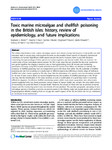Toxic marine microalgae and shellfish poisoning in the British isles: history, review of epidemiology, and future implications.
| dc.contributor.author | Hinder, SL | en |
| dc.contributor.author | Hays, GC | en |
| dc.contributor.author | Brooks, CJ | en |
| dc.contributor.author | Davies, AP | en |
| dc.contributor.author | Edwards, M | en |
| dc.contributor.author | Walne, AW | en |
| dc.contributor.author | Gravenor, MB | en |
| dc.date.accessioned | 2019-11-27T12:19:14Z | |
| dc.date.available | 2019-11-27T12:19:14Z | |
| dc.date.issued | 2011-06-06 | en |
| dc.identifier.uri | http://hdl.handle.net/10026.1/15197 | |
| dc.description.abstract |
The relationship between toxic marine microalgae species and climate change has become a high profile and well discussed topic in recent years, with research focusing on the possible future impacts of changing hydrological conditions on Harmful Algal Bloom (HAB) species around the world. However, there is very little literature concerning the epidemiology of these species on marine organisms and human health. Here, we examine the current state of toxic microalgae species around the UK, in two ways: first we describe the key toxic syndromes and gather together the disparate reported data on their epidemiology from UK records and monitoring procedures. Secondly, using NHS hospital admissions and GP records from Wales, we attempt to quantify the incidence of shellfish poisoning from an independent source. We show that within the UK, outbreaks of shellfish poisoning are rare but occurring on a yearly basis in different regions and affecting a diverse range of molluscan shellfish and other marine organisms. We also show that the abundance of a species does not necessarily correlate to the rate of toxic events. Based on routine hospital records, the numbers of shellfish poisonings in the UK are very low, but the identification of the toxin involved, or even a confirmation of a poisoning event is extremely difficult to diagnose. An effective shellfish monitoring system, which shuts down aquaculture sites when toxins exceed regularity limits, has clearly prevented serious impact to human health, and remains the only viable means of monitoring the potential threat to human health. However, the closure of these sites has an adverse economic impact, and the monitoring system does not include all toxic plankton. The possible geographic spreading of toxic microalgae species is therefore a concern, as warmer waters in the Atlantic could suit several species with southern biogeographical affinities enabling them to occupy the coastal regions of the UK, but which are not yet monitored or considered to be detrimental. | en |
| dc.format.extent | 54 - ? | en |
| dc.language | eng | en |
| dc.language.iso | eng | en |
| dc.subject | Environmental Monitoring | en |
| dc.subject | Epidemiological Monitoring | en |
| dc.subject | Humans | en |
| dc.subject | Incidence | en |
| dc.subject | Microalgae | en |
| dc.subject | Shellfish Poisoning | en |
| dc.subject | United Kingdom | en |
| dc.subject | Wales | en |
| dc.title | Toxic marine microalgae and shellfish poisoning in the British isles: history, review of epidemiology, and future implications. | en |
| dc.type | Journal Article | |
| plymouth.author-url | https://www.ncbi.nlm.nih.gov/pubmed/21645342 | en |
| plymouth.volume | 10 | en |
| plymouth.publication-status | Published online | en |
| plymouth.journal | Environ Health | en |
| dc.identifier.doi | 10.1186/1476-069X-10-54 | en |
| plymouth.organisational-group | /Plymouth | |
| plymouth.organisational-group | /Plymouth/Faculty of Science and Engineering | |
| plymouth.organisational-group | /Plymouth/REF 2021 Researchers by UoA | |
| plymouth.organisational-group | /Plymouth/REF 2021 Researchers by UoA/UoA07 Earth Systems and Environmental Sciences | |
| dc.publisher.place | England | en |
| dcterms.dateAccepted | 2011-06-06 | en |
| dc.identifier.eissn | 1476-069X | en |
| dc.rights.embargoperiod | Not known | en |
| rioxxterms.funder | Natural Environment Research Council | |
| rioxxterms.identifier.project | SAHFOS Continuous Plankton Recorder | |
| rioxxterms.versionofrecord | 10.1186/1476-069X-10-54 | en |
| rioxxterms.licenseref.uri | http://www.rioxx.net/licenses/all-rights-reserved | en |
| rioxxterms.licenseref.startdate | 2011-06-06 | en |
| rioxxterms.type | Journal Article/Review | en |
| plymouth.funder | SAHFOS Continuous Plankton Recorder::Natural Environment Research Council | en |


